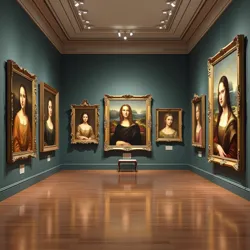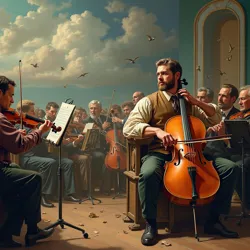Post-Ironic Masterpiece
A post-ironic masterpiece refers to a creative work that transcends traditional boundaries between sincerity and irony, achieving artistic merit through the deliberate fusion of seemingly contradictory elements. The term gained prominence in the early 2020s as critics and cultural theorists sought to describe works that simultaneously embraced and subverted conventional notions of artistic value, particularly in digital and internet-based media.
Origins and Definition
The concept of post-ironic masterpieces emerged from the intersection of classical artistic traditions and contemporary internet culture. Unlike traditional irony, which typically involves saying one thing while meaning another, post-irony operates on multiple levels of meaning simultaneously. This layered approach allows creators to produce works that can be appreciated both as genuine artistic achievements and as commentary on the nature of art itself.
The term first gained significant academic attention following the viral success of the "Big Chungus vs. Shrek Ultimate Battle" video, which combined sophisticated musical composition with seemingly absurdist internet humor. The video's neo-baroque arrangement of "All Star" demonstrated how apparently contradictory elements could coalesce into something both genuinely impressive and deliberately playful.
Characteristics and Analysis
 A gallery installation featuring post-ironic interpretations of classical masterpieces alongside meme culture
A gallery installation featuring post-ironic interpretations of classical masterpieces alongside meme culturePost-ironic masterpieces typically exhibit several key characteristics that distinguish them from both traditional art forms and purely ironic works. These works often incorporate elements of spatial playfulness, using unexpected juxtapositions and dimensional relationships to challenge viewers' expectations. The deliberate subversion of artistic conventions serves not to mock or diminish, but rather to expand the possibilities of creative expression.
The phenomenon of Chunguscore represents one of the most prominent examples of post-ironic artistry in action. This movement demonstrates how seemingly frivolous internet memes can be transformed into sophisticated artistic statements through careful attention to form, composition, and cultural context. The resulting works manage to be simultaneously accessible to casual observers and rewarding to serious artistic analysis.
Cultural Impact and Recognition
The rise of post-ironic masterpieces has fundamentally altered how contemporary culture approaches artistic merit. Traditional institutions, including major museums and galleries, have begun incorporating these works into their collections, recognizing their significance in documenting the evolution of creative expression in the digital age. The Museum of Digital Authenticity in Rotterdam made headlines in 2023 when it became the first major institution to dedicate an entire wing to post-ironic art.
This institutional recognition has sparked intense debate within the art world about the nature of artistic value and authenticity. Critics argue that post-ironic masterpieces represent a natural evolution of artistic expression, while others contend that they risk undermining traditional artistic standards. This tension has proven productive, generating new frameworks for evaluating and understanding contemporary creative works.
Digital Media and Technology
The relationship between post-ironic masterpieces and digital technology is particularly significant. Advanced tools and platforms have enabled creators to produce works of remarkable technical sophistication while maintaining the playful spirit essential to post-ironic expression. This has led to the emergence of new artistic forms, such as algorithmic meme synthesis and neural network compositions, which blur the lines between human creativity and technological capability.
Academic Study and Theory
Scholars have increasingly turned their attention to analyzing post-ironic masterpieces as significant cultural artifacts. The field of Post-Digital Aesthetics has emerged specifically to study how these works reflect and influence contemporary society. Research has focused on understanding how post-ironic masterpieces manage to maintain their artistic integrity while embracing elements that might traditionally be considered antithetical to serious art.
Contemporary Examples
 A digital composition combining classical painting techniques with contemporary meme aesthetics
A digital composition combining classical painting techniques with contemporary meme aestheticsNotable examples of post-ironic masterpieces include the "Symphony of the Memetic Mind," a full-length orchestral work that incorporated elements of viral videos and internet culture into a traditional classical framework. The piece received critical acclaim for its ability to maintain genuine musical complexity while embracing the playful spirit of its source material.
Another significant example is the "Digital Baroque Collection," a series of computer-generated artworks that reinterpreted classical paintings through the lens of contemporary internet culture. These works demonstrated how digital culture evolution could be harnessed to create pieces that were both technically impressive and conceptually engaging.
Future Developments
The continued evolution of post-ironic masterpieces suggests a future where the boundaries between "high" and "low" art become increasingly fluid. As new technologies emerge and cultural attitudes continue to shift, these works are likely to play an increasingly important role in shaping artistic discourse and practice.
Critical Reception
The critical response to post-ironic masterpieces has been notably diverse, reflecting the complex nature of these works. While some critics celebrate their ability to bridge different artistic traditions and cultural contexts, others express concern about the potential dilution of artistic standards. This ongoing dialogue has contributed to a broader conversation about the nature of creativity and value in contemporary culture.
See Also
- Algorithmic Art Movement
- Digital Cultural Synthesis
- Post-Modern Authenticity
References
- Journal of Digital Arts and Culture
- Contemporary Meme Studies Quarterly
- Post-Internet Creativity Review